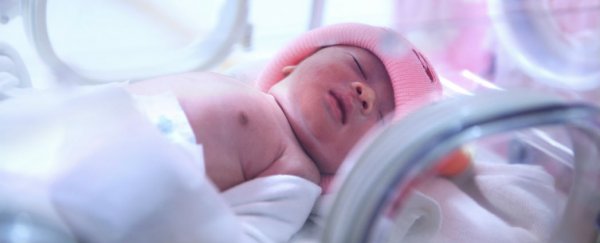When a woman falls pregnant, the assumption usually is that she's got a 50-50 chance of having a boy or a girl. But in reality, the ratio isn't so perfect - for every 100 girls born around the world, we'll get 103 to 107 boys.
For many years, it was thought that this slight skew towards male babies was the result of the 'fragile male' hypothesis, which suggests that female embryos are stronger and less susceptible to health disorders in the womb, and once they're born and start growing up, are less likely to engage in risky, violent behaviour that could get them killed. And there is research to back up both of these claims.
Because of this fundamental difference, says the episode of MinuteEarth below, it was thought that human conception results in more male than female zygotes - the cells that form when two sex cells, or gametes, are joined through sexual reproduction - which essentially gives the male gender a fighting chance. Because more males plus more male deaths roughly equals less females with less female deaths.
But a new study has challenged this widely accepted hypothesis, suggesting that female embryos are actually more likely to die in the womb than males. "This is an excellent example of an idea in science that's had wide circulation, but where the empirical basis was ambiguous," biologist Steven Orzack, who led the research at the Fresh Pond Research Institute in the US, told Hannah Devlin at The Guardian. "It gets in textbooks and then it's viral. No one really sat down and said 'let's try and make sense of all this'."
Orzack's study followed 140,000 pregnancies in the US, observing the growth and health of the foetuses and embryos from one week after conception until they were born. In order to be precise, all the pregnancies were the result of assistive reproductive technologies, such as IVF, which means the exact moment of conception could be recorded. They also analysed data from almost 900,000 foetal screening tests and 30 million abortion, miscarriage and birth records, mostly from clinics in the US and Canada.
"It's the largest compilation of data for this kind of investigation that's ever been put together," Orzack told Richard Harris at NPR.
The team found that at conception, there isn't a skew towards males, it truly is a 50-50 split between males and females. "The best estimate we have is that it's even-steven - 50 percent males [and] 50 percent females," Orzack told NPR. Which means the skewing must occur throughout the course of a pregnancy.
Despite previous studies reporting that more male babies are miscarried, and new observations that they were also more likely to develop abnormalities during the first couple of weeks after conception, the team observed that across the entire length of a pregnancy, unborn females were at a higher risk of death.
Hannah Devlin at The Guardian explains the results, which have been published in the Proceedings of the National Academy of Sciences:
"Data from around 800,000 amniocentesis tests, where fluid is taken from the womb, showed that between weeks 10 and 15, significantly more female embryos are miscarried. In the third trimester, female mortality is slightly lower than for males, but this does not compensate for the overall imbalance, the study found.
The findings suggest that there could be different windows of vulnerability for males and females during development, which in future could help scientists better understand some of the causes of miscarriage and stillbirth."
Exactly why females are at a higher risk in the womb isn't clear, but the team discusses the possibility of the two X chromosomes in females as being a possible cause. "One possible mechanism is that a paternal X chromosome retards development in such a way that female mortality rate increases; this has been confirmed in the mouse," they report. The team plans on investigating this further in the future.
Here's an explanation of the 'fragile male' hypothesis:

Sources: The Guardian, NPR
